Volcanoes
Volcanoes
Volcanoes come in many shapes and sizes, and their eruptions vary hugely in both frequency and intensity. Many volcanoes are tourist attractions and are worth a visit provided you take due care, in particular keeping a safe distance from eruptions.
Volcanic eruptions are not all that common — a few dozen a year, worldwide — and are extremely dangerous. The worst of them cause complete devastation over wide areas, sometimes with a large death toll. Despite the risk, due to the renowned fertility of volcanic soil, there are often large agricultural settlements in close proximity to a volcano.
Understand
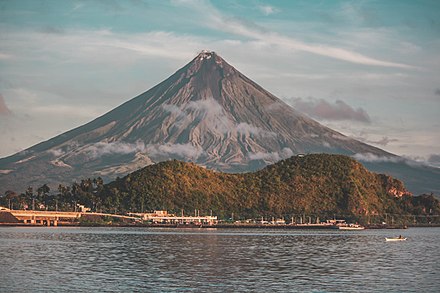 Perhaps the best-known type of volcano is the stratovolcano which is built up from multiple layers of ash and lava over centuries, giving a conical shape. Several of the world's most famous volcanoes, such as Mount Fuji, Mount Etna and Kilimanjaro, are of this type. Filipino tourist literature claims their Mayon Volcano has the world's most perfect cone.
Perhaps the best-known type of volcano is the stratovolcano which is built up from multiple layers of ash and lava over centuries, giving a conical shape. Several of the world's most famous volcanoes, such as Mount Fuji, Mount Etna and Kilimanjaro, are of this type. Filipino tourist literature claims their Mayon Volcano has the world's most perfect cone.
A complex stratovolcano has multiple cones and/or multiple calderas; examples include the Three Sisters in Oregon and Taal Volcano in the Philippines.
A somewhat less common type is a shield volcano, formed when the lava is less viscous and therefore spreads out much further. Most of Hawaii's volcanoes are of this type.
According to the Smithsonian Global Volcanism Program, the major volcano monitoring organization based in Washington, DC, volcanoes can be classified as follows:
-
active if
- it has erupted within the last 10,000 years<br/>(recently in geological terms)
- or it shows considerable activity<br/>hot springs, fumes, earthquakes, etc.
-
dormant (French for sleeping) if it is active but not currently erupting
-
extinct if it is no longer active Other organizations generally use the same terms, but may have somewhat different definitions. These definitions are not precise; a volcano classed as active may do nothing interesting for hundreds of years, and volcanoes considered dormant sometimes erupt. A volcano classed as extinct is quite unlikely to come back to life, but there is no absolute guarantee.
-
Decade Volcanoes. These are 16 active volcanoes selected by scientists as particularly worthy of study because they both have a history of large eruptions and are located near populous areas. These may be the most dangerous volcanoes on Earth in terms of potential to create large disasters. 2020-05-04
-
Pacific Ring of Fire. This is a group of active tectonic areas, including many volcanoes, running around the Pacific Ocean. On the east, this means the Andes and the Rocky Mountains. On the west, the ring runs through Russia's Kamchatka, Japan, the Philippines, Indonesia and all the way to New Zealand. There are hundreds of active volcanoes around the world, but many more that are dormant or extinct. One can still appreciate the awesome power of nature from these volcanoes, without the hazards that go with active ones.
Measurement scale
There is a scale for the force of eruptions called the Volcanic Explosivity Index or VEI; the main factor is the volume of ejecta, the amount of material spewed out. The scale is logarithmic; a VEI-5 eruption produces at least 1 km<sup>3</sup> of ejecta, VEI-6 10 km<sup>3</sup>, VEI-7 100 km<sup>3</sup>, and VEI-8 1000 km<sup>3</sup>.
Really large eruptions are quite rare. The 20th century had three VEI-6 eruptions, ten VEI-5, and hundreds of smaller ones, but none of VEI-7 or above. As of late 2022, the 21st century has had two VEI-5 or 6 events and nothing larger. The most recent VEI-7 events were Lake Taupo (New Zealand) in 180 CE, Ilopango (El Salvador) around 431, Mount Paektu (on the Korean-Chinese border) around 946, possibly Mount Rinjani (Indonesia) in 1257, and Mount Tambora (Indonesia) in 1815. As for VEI-8, there has not been such an event in recorded history; the most recent was at Lake Taupo about 26,500 years ago.
The VEI-7 Tambora eruption of 1815 put out 160 cubic km (38 cubic miles) of ejecta, including enough dust and ash to cause "the year without a summer", widespread crop failure and some famine as far away as the US and Europe. Said "year without a summer" led the German Karl Drais to invent a "walking machine" which is today considered the first ancestor of the modern bicycle.
- Types of eruption. Volcanologists classify eruptions into several types. In general, a traveller need not care about this, but those who want to understand the science should look at the classification. A phreatomagmatic eruption may have huge explosions when a large amount of water is instantly turned to steam on contact with superheated magma. The 1883 eruption of Krakatoa was VEI-6, much smaller than Tambora, but it is more famous because the explosions were absolutely enormous. The Hunga Tonga eruption of 2022 was similar since that volcano is under the sea.
A strombolian eruption is not very powerful (VEI-1 or 2) but may last a long time. Stromboli has been erupting more-or-less continuously for several thousand years.
Supervolcanoes
Supervolcanoes are the largest volcanoes on Earth, but are not easily recognizable as such. Many are so big that, for many years, even geologists did not appreciate that these features were volcanoes in their own right.
Supervolcanoes are generally in the form of large calderas (Spanish for "cauldron"), which are giant volcanic depressions formed either by large explosive eruptions or quiet long-term drainage of magma. They often have associated lava flows or domes, and in many cases there are smaller volcanoes within the caldera. Many of the calderas are now lakes, and sometimes the smaller volcanoes are islands in the lake.
Examples of supervolcanoes include Yellowstone in the United States, Lake Toba and Mount Tambora in Indonesia, the Phelgraean Fields near Naples in Italy, and Lake Taupo in New Zealand. Most supervolcanoes have undergone unimaginably huge eruptions (VEI-7 or 8) in the geologic past; these are what created the huge caldera. However, such eruptions are tens or hundreds of thousands of years apart. There is no reason to worry that Yellowstone, for example, will explode during your visit; it had several huge eruptions in the past, but none since a VEI-8 event 640,000 years ago.
Geothermal areas
Throughout volcanic areas of the world, one may also encounter geothermal areas. These places are often, but not always, associated with volcanic activity. Hot springs, geysers, mud pools and fumaroles (steam/gas vents) are common scenic features in geothermal areas, and hot springs can be great places to take a dip. Countries such as Japan, South Korea, Taiwan and Iceland are especially famous for hot spring baths. Geothermal areas are also an environmentally friendly source of energy, and Iceland takes advantage of this very well.
Yellowstone National Park is probably the best known example of a geothermal area, as molten magma lies not far beneath its 640,000-year-old caldera. New Zealand, with its volcanoes in the North Island, is also known for extensive geothermal areas, with Rotorua perhaps being the best known one. Geysir in Iceland, which is the namesake for all geysers in the world, is another famous geothermal region. The Maori people of New Zealand, who traditionally cooked their food by burying it underground with heated rocks (known as a hangi), often make use of the geothermal heat instead if they live in a geothermally active area. Similarly, Iceland has a tradition of baking rye bread underground using the geothermal heat.
Stay safe
Scientists can make predictions about volcanic activity, and those predictions are good enough to make it essential for travellers to check for current warnings when planning any trip to a volcanic area. However, the problem is complex so predictions are generally not precise and sometimes not entirely reliable. Local media or tourist offices are the usual sources for warnings, but many countries have a government-run volcano monitoring organization which is the definitive source.
.jpg/440px-Etna_Volcano_Paroxysmal_Eruption_July_30_2011_-_Creative_Commons_by_gnuckx_(3).jpg) Public safety authorities may order hazard areas evacuated and visitors should certainly follow such advice. However, the onset of some volcanic events can be quite sudden, and authorities are sometimes slow to act since evacuations are disruptive, expensive and sometimes controversial. When an order is given, it may be difficult to comply since transportation may be disrupted or overcrowded.
Public safety authorities may order hazard areas evacuated and visitors should certainly follow such advice. However, the onset of some volcanic events can be quite sudden, and authorities are sometimes slow to act since evacuations are disruptive, expensive and sometimes controversial. When an order is given, it may be difficult to comply since transportation may be disrupted or overcrowded.
If you are near a volcano that begins to act restless — perhaps earth tremors or expelling steam or dust — it may be wise to consider leaving the area without waiting for an evacuation order.
Volcanoes are complex and can be quite different from each other, so for most of them it is a good idea to have an expert guide who knows the particular mountain you want to visit. If you want to go anywhere near an erupting volcano, then a guide is absolutely essential. On the other hand, climbing some volcanoes without a guide is reasonable; for example Mount Fuji has not erupted since 1708, scientists are not issuing warnings, and there are well-marked trails.
Volcanic activity is often associated with earthquakes or tsunamis, and some volcanoes are high enough that altitude sickness is a risk. Each of those has another whole set of hazards; see the linked articles.
Equipment
Good footwear is essential since many volcanic rocks have sharp edges and some are hot. Also, the terrain is often irregular and good boots will reduce the risk of a stubbed toe or turned ankle. A sturdy pair of hiking boots are the usual choice, but some use construction boots with steel in the toes and soles, and some choose lighter shoes for comfort. In any case, look for thick soles, preferably in a material such as Vibram which does not melt easily.
Other equipment — such as heavy work gloves, a helmet, safety googles, a walking stick, a facemask for dust and a gas mask for poisonous fumes — may be needed as well.
For some volcanoes, mountaineering skills and equipment are needed. On a few, snakebite is also a hazard and high leather boots are the simplest protection.
Eruptions
An erupting volcano is extremely dangerous. Unless you have an excellent reason for going near one, the best advice is to stay away and watch it from a considerable distance, or even from the safety of your home or hotel on the TV news.
Volcano hazard zones can extend for dozens of kilometers, and there are multiple hazards:
- Lava is molten rock spewing forth from the volcano. In addition to the direct danger, a large lava flow radiates enough heat to ignite vegetation and kill animals at a considerable distance.
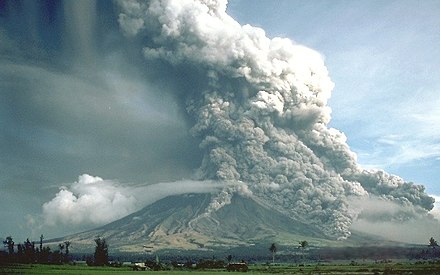
- Pyroclastic flows are streams of red-hot ash and debris that rush downslope from their source vents, incinerating anything flammable in their path. They can reach temperatures up to 800°C (over 1400°F) and travel at up to 150 km/h (almost 100 mph).
- Volcanic bombs are rocks thrown upward by eruptions; many are ejected as blobs of molten rock that solidify while airborne, so they may still be dangerously hot when they land. Large ones are generally not thrown far or high, but they can be any size up to that of a house and are spectacularly dangerous. Smaller ones can be thrown thousands of meters high and may land dozens of km away, and even an egg-sized rock can kill if it drops from a great height. A hard hat will reduce this danger somewhat, but not to anywhere near zero.
- Jökulhlaups are floods caused by the volcano melting parts of a glacier, possibly a part that functions as dam of a glacier lake. On Iceland there have been peak discharges in the order of magnitude of floods of the Amazon River. Bridges downstream from Vatnajökull used to get destroyed on a regular basis. Volcanoes can also cause floods when a crater wall collapses releasing the lake within, by melting snow that is not part of a glacier, or by blocking rivers.
- Lahars are avalanches of mud created when a deposit of volcanic ash becomes mobile when it gets wet from rainfall or from a flood. They can occur long after eruptions, travel many kilometers at high speed, and be devastating. While there are usually some warning signs before eruptions, lahars often occur with no warning.
- Steam is dangerous, perhaps just scalding but in some cases (Krakatoa or some geysers) explosive. In many cases, hot water or hot mud are nearly as hazardous.
- Lethal gasses are gasses from eruptions, typically carbon dioxide and sulphur dioxide. Often, but not always, the stink of sulphurous compounds provides a warning; avoid areas with a rotten egg smell. Also try to stay upwind of any vents releasing gasses; assume any vent with steam may also have nastier gasses. Walking toward a vent, keep the wind at your back; walking away, keep it in your face.
- Vog or volcanic smog is a nasty combination of water droplets with dissolved gasses, possibly plus volcanic dust. Since SO<sub>2</sub> in water becomes sulphurous acid, this is highly irritating to eyes and throat. In high concentrations or for vulnerable people — asthma, heart or lung disease, children, pregnant women, the elderly, etc. — it can be fatal. If you are exposed, a face mask gives some protection and drinking lots of water will soothe the throat.
Any of those can kill, but the ones that claim the most lives are pyroclastic flows and lahars because they often occur suddenly, they move very fast, and they can travel surprisingly long distances. Do not go anywhere that they are likely. If you get hit by either of these, your chances of survival are almost zero. If you are in the path, you are unlikely to outrun it, even with a vehicle; your best chance may be to try to get off the path by moving perpendicular to the flow or diagonally.
Staying on high ground when observing a volcano gives you a better view and reduces several hazards. The dangerous gasses are heavier than air and collect in low-lying areas, and lava, pyroclastic flows, lahars and floods all tend to follow the contours of the land. A combination of distance and altitude also reduces the risk from volcanic bombs. Often the best place to observe is from high on the other side of a valley, well away from the volcano; bring binoculars.
Most photographers will shoot a volcanic eruption from a good distance with a telephoto lens, but others find they get better results by moving closer; this may reduce blurring due to dust and ash and the distortions caused by hot air. It should be attempted only with considerable caution, preferably with an expert guide.
Ashfall, volcanic mudflows, and the effects of earthquakes can extend for hundreds of kilometers away from the volcano. The most famous victim of ashfall was the Roman city of Pompeii, buried in 79 CE by Mount Vesuvius. Those two were only about 8 km (5 miles) apart, but ash can also be transported by air in vast quantities over a huge area. The enormous (VEI-8) prehistoric eruption of Yellowstone spread a layer of ash, close to two meters thick in places, over most of the US and parts of Canada and Mexico.
Volcanic ash tends to stop aircraft and vehicle engines, so transportation may be disrupted. An eruption in Iceland in 2010 shut down airports for weeks more than 1,000 km away in mainland Europe, but mostly the affected area is smaller, less than 100 km from the volcano. In some cases, boats and roads may also be shut down.
Dormant volcanoes
When a volcano is dormant, you are mostly safe even close to it, but there are some issues. Lava flows can still be hot for years after an eruption and only a thin crust of rock may be covering them. Old lava flows can be sharp as broken glass, so you should wear hiking boots or very thick shoes. To add to these dangers, lethal gases may be seeping out of vents near the volcano – and some can have a new eruption without much warning.
Lahars can also occur around dormant volcanoes, whenever a deposit of volcanic ash gets wet. They can travel many kilometers, and be devastating. While there are often some warning signs before eruptions, lahars can have no warning. Watch out for possible lahars when there are heavy rains.
Geothermal areas
Geothermal areas can have hazards similar to those of volcanoes due to geological mechanisms. Hot springs and mud pools can be dangerous due to heat, acidity, or poison, so do not go near these areas unless you know for sure that they are totally safe. Geysers are a common feature of major geothermal areas, and can erupt hot water or mud unexpectedly.
Landslides are also common in geothermal areas, as even volcanic rock can become weakened over time. Acidic fumes can seep out of fumaroles (steam/gas vents) or hot springs. Noxious gases can also be encountered coming out of holes in the ground, and the gases can reach dangerous levels in enclosed spaces like caves, manholes, or pool enclosures. Carbon dioxide, which is a byproduct of volcanic activity, is known for going into enclosed spaces and it can kill swiftly with little or no warning.
Destinations
A selection of some of the more active and/or better known volcanoes in the world today. Some of these can still be explored from up close.
Africa
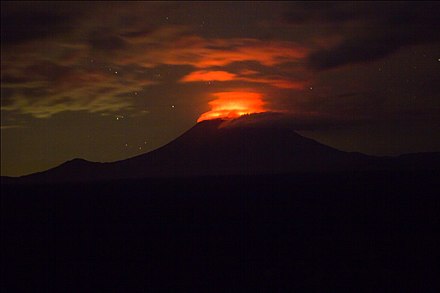
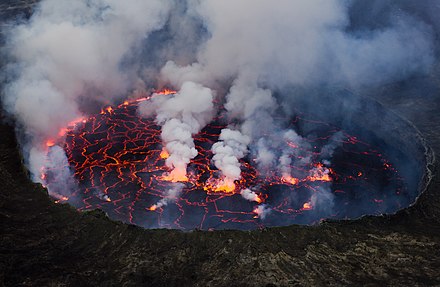
-
Mount Cameroon (Mongo ma Ndemi), 4.216667°, 9.1725°. The only volcano outside of Europe to have records of an eruption before the Common Era in 5 BCE. It remains active today: its most recent eruption was in 2012. Near the city of Buea.
-
Mount Kilimanjaro, -3.075833°, 37.353333°. This peak in Tanzania is Africa's tallest at 5895 m (19,340 ft). It has a series of concentric summit craters apparently less than 10,000 years old and may have last erupted less than 2000 years ago. The name Kilimanjaro means "shining mountain" in Swahili, no doubt due to the once-extensive glaciers which are unfortunately disappearing rapidly each year.
-
Mount Nyiragongo, -1.516667°, 29.25°. In Virunga National Park in the far eastern D.R. Congo, near Goma and the Rwanda border. One of just four volcanoes in the world with a persistent lava lake, the others being Erta Ale (Ethiopia), Kilauea (Hawaii), and Mount Erebus (Antarctica). The volcano is usually accessed by overnight hike (8–10 hr up first day, hike down the following morning), with the night spent in tents on the rim of the caldera with stunning views of the lava lake and the surrounding region. Unfortunately, it is located in a conflict zone and access is occasionally blocked due to the presence of rebels and criminal gangs. It is a Decade Volcano.
-
Ol Doinyo Lengai ("Mountain of God" in the Masai tongue), -2.764444°, 35.916111°. In Ngorongoro Conservation Area in Tanzania, this is the only volcano on Earth that erupts natrocarbonatite lava. This type of lava emerges black, cools to grey, and oxidizes to white.
-
Volcanoes National Park, -1.48°, 29.53°. This park in Rwanda is famous as the home of mountain gorillas. Visiting requires an advance reservation, an expensive permit, and some hiking.
Asia
China
.jpg/440px-Laika_ac_Mt._Paekdu_(7998657081).jpg)
- Arxan Geopark. Part of the UNESCO Global Geoparks Network, has volcanoes, crater lakes and hot springs.
- Mount Paektu (Baekdu Mountain). This is an active stratovolcano on the North Korean/Chinese border, with a beautiful crater lake. It plays an important role in both Korean and Manchu culture and mythology.<br/>It had a VEI-7 blast in about 946 CE and most recently erupted in 1903. Some experts believe an eruption in the 21st century is likely.
The Chinese side is in the Changbaishan National Nature Reserve. It is much more difficult to visit the other side, in North Korea's Baekdu Mountains region.
India
- Barren Island. This is the only volcano in the Andaman Islands and the only active volcano in India. Day trips can be arranged from Port Blair. No additional permit is required to visit the island, but it is not possible to land on the island, only to view it from the boat. 2020-05-05
Indonesia
With 167 known active volcanoes, Indonesia is the world's most volcanic country by far. The Volcanological Survey of Indonesia (website in Indonesian) is the government agency responsible for monitoring and warnings.

- Krakatoa, -6.102°, 105.423°. This is an island in West Java province with several volcanoes on it which produced multiple explosions in 1883. The largest is estimated to have been equivalent to 200 megatons of TNT, about four times the largest H-bomb ever tested, and the sound was heard 5000 km away. The dust cloud had worldwide effects; global temperatures dipped by over a degree. This was a VEI-6 event.
- Mount Batur. A very accessible active volcano which takes just 2 hours to climb.
- Mount Agung. A highly visible volcano in the interior of Bali. "Agung" means "great" in Indonesian. The volcano is considered quite sacred by Balinese people, and its slopes are home to the beautiful temple complex of Besakih. Its last eruption, in 1963, was quite devastating.
- Mount Bromo. Known for its unreal scenery, this is a popular tourist destination. It is one of five newer volcanoes within the caldera of a large ancient one and is surrounded by a sea of sand. Climbing Mount Bromo gives a good view of nearby Mount Semuru.
- Mount Semeru, -8.107778°, 112.921944°. Indonesia's third highest active volcano. An eruption in December 2021 buried some villages in ash and killed a few dozen people. Both Bromo and Semeru are in Bromo-Tengger-Semeru National Park. A permit from the park office is required to climb Semeru; they stopped issuing these due to the 2021 eruption and have not yet restarted as of March 2022.
- Mount Merapi. Perhaps Indonesia's single most active volcano (no mean feat). It looms large over the major cities of Yogyakarta and Solo, and the very popular temples of Borobudur and Prambanan. Merapi has erupted 68 times since formal record-keeping began in the 16th century. Its eruption on May 11, 2018, prompted the evacuation of areas within a 5-kilometre (3.1 mi) radius of the volcano, and the closure of the Yogyakarta airport. It is a Decade Volcano.
- Mount Rinjani. Indonesia's second highest volcano with a stunning crater lake. It's a two-day trek to the crater rim.
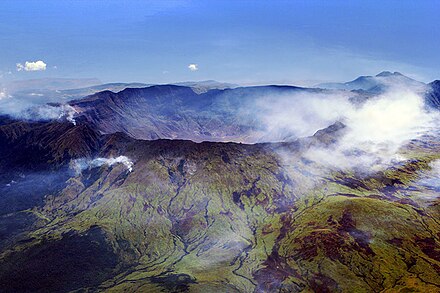
- Mount Tambora, -8.24°, 117.99°. This stratovolcano is one for the truly adventurous; only about 50 visitors a year make it to its very remote location.
In 1814 Tambora was high. It erupted with such force (VEI-7) the following year that was lost from its top. That was much the largest eruption in recent history, about ten times more powerful than the Krakatoa eruption a few decades later. It put enough dust and ash into the atmosphere to cause a "volcanic winter" that affected most of the Northern hemisphere; livestock deaths and crop failures caused the worst famine of the century. Wikipedia has a list of volcanoes in Indonesia.
Japan

-
Mount Aso, 32.8844°, 131.1039°. This is one of the largest active volcanoes in the world with the largest caldera.
-
Mount Fuji, 35.360628°, 138.727365°. Located near Tokyo, this is Japan's highest and most beautiful volcano. It is also the most climbed mountain in the world and a place of religious significance in Shinto worship.
-
Mount Daisen, 35.371111°, 133.546389°. A dormant stratovolcano, also significant in Shinto.
-
Sakurajima, 31.580556°, 130.658056°. This is an active volcano just outside of Kagoshima. It is a Decade Volcano.
-
Mount Unzen, 32.761389°, 130.298611°. This is a complex stratovolcano. It is a Decade Volcano.
Philippines
The Philippine Institute of Volcanology and Seismology lists 24 volcanoes as "active"; 21 of those have erupted in the last 600 years. Another 25 are listed as "potentially active" and 355 as "inactive".
The four most active, in order, are:

- Mayon Volcano, 13.256667°, 123.685°. Often described as the world's most perfect volcano cone, Mayon had a fatal eruption in 1993.
- Taal Volcano, 14°, 120.98°. This is a complex volcano system described as a "lake in a volcano in a lake" and one of the most picturesque landscapes in the Philippines. It has a history of destructive eruptions and is the country's only Decade Volcano. An eruption in early 2020 forced the evacuation of several towns.
- Mount Kanlaon, 10.370556°, 124.742778°. The highest mountain in the Visayas, a stratovolcano near the major city Bacolod. There are marked hiking trails. A sudden eruption in 1996 killed several hikers.
- Mount Bulusan, 12.77°, 124.05°. A stratovolcano with several other craters, volcanic lakes and hot springs. There is a national park around it. Except for Kanlaon, these are all in southern Luzon.
Other volcanoes include:
- Mount Pinatubo, 15.141667°, 120.35°. A stratovolcano which had a VEI-6 eruption in 1991, the second largest on Earth in the 20th century.
- Mount Makiling, 14.13°, 121.2°. A dormant stratovolcano, sacred in the old local religion. At its foot is the town of Los Baños, a popular resort on a lake and close (63 km) to Manila. It is named for its hot springs, certainly pleasant and reputedly therapeutic.
- Mount Apo, 6.9875°, 125.270833°. This dormant stratovolcano is the highest peak in the Philippines at 2,954 meters (9,692 ft). It is fairly often climbed, but this is not easy; it requires mountaineering skills and equipment, and a guide.
- Lake Apo, 7.880278°, 125.006111°. A scenic crater lake, caldera of an extinct volcano. The region has several other volcanoes.
- Bud Dajo, 6.01333°, 121.056667°. An extinct volcano, sacred in the old local religion. It was the scene of a battle in 1906 in which US Navy ships shelled people hiding in the crater. Wikipedia has a list of active volcanoes in the Philippines.
Turkey
- Mount Ararat. A dormant permanently snow-capped volcano with two distinct peaks. It is the most sacred site in the world for the Armenia people, who consider it to be the site of the founding of their nation.
Russia
Kamchatka, Russia's largest Pacific peninsula, has several active volcanoes and some hot springs and geysers
- Avachinsky-Koryaksky. These two volcanoes, close to each other and to the region's capital Petropavlovsk-Kamchatsky, have been jointly designated a Decade Volcano.
Europe
Canary Islands
- El Teide, 28.2727°, -16.6423°. This volcano in Tenerife is the highest active volcano in the Canary Islands at 3715 m (12,188 ft). A flank vent at El Teide was observed erupting by Christopher Columbus and his crew in 1492. El Tiede is one of the Decade Volcanoes. It is in Teide National Park, a .
Greece
-
Nisyros, 36.583333°, 27.166667°. This island in the Greek Dodecanese islands is the top of a volcano, mildly active with smoking fumaroles. It is possible to walk into the crater floor for a closer look.
-
Santorini, 36.4067°, 25.4333°. This island in the Aegean Sea is the largest of a ring of islands around an ancient caldera, and probably Greece's most famous volcano. It had a VEI-7 eruption around 1600 BCE. Some historians suggest the associated tsunami and earthquakes destroyed the Minoan civilization on nearby Crete, or that the devastation of these islands is the origin of the Atlantis myth, but both those theories are quite controversial.
The volcano is still active, for it last erupted in 1950 out of Nea Kameni ("New Burnt" in Greek), an island made up of lava flows in the middle of the caldera bay. It is the country's only Decade Volcano.
Iceland
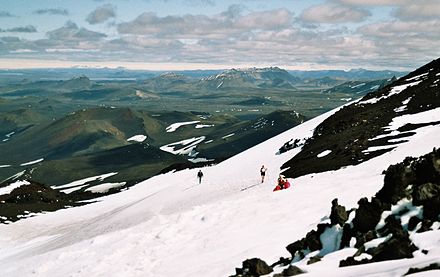
Iceland 📍 has many active volcanoes, among them Hekla, Katla and Askja. In medieval times Hekla was thought to be a gateway to Hell. It has had five eruptions since 1947 (the last being in 2000), and is regarded as unpredictable. A volcano below the Eyjafjallajökull glacier famously disrupted European air travel for days with an ash cloud released during an eruption in 2010.
Some Icelandic volcanoes are featured in fiction. Snæfellsjökull is in Jules Verne's novel Journey to the Centre of the Earth and many parts of the Game of Thrones TV series were shot in Þingvellir National Park.
Italy
- Vesuvius, 40.816667°, 14.433333°. This is a dormant volcano near Naples. It has not been smoking since it last erupted in 1944, but it is still very closely and carefully monitored because of its seriously hazardous proximity to that city, which is southern Italy's most populous. It is famous for its eruption in 79 CE, which buried the Roman cities of Pompeii and Herculaneum under layers of pumice, ash and lava fragments.
- Mount Etna. This is Europe's tallest volcano at and is quite active. 2020-05-05 Both Etna and Vesuvius are Decade Volcanoes.
- Phlegraean Fields (Campi Flegrei). This is the caldera of a supervolcano near Naples; the town of Pozzuoli is within it. It had a VEI-7 eruption some 39,000 years ago.
- Vesuvius Observatory (Osservatorio Vesuviano). This centre monitors the three volcanoes in the Campania region: Vesuvius, the Phlegraean Fields and Ischia.
- [Stromboli](https://www.swisseduc.ch/stromboli/), 38.79°, 15.21°. This volcano in the Aeolian Islands has been in near continuous activity since at least the time of the Ancient Greeks and has been billed as the "Lighthouse of the Mediterranean".
North America and Caribbean

- The Aleutian Islands and the associated Alaska Peninsula are volcanic in origin and have several active volcanoes.
- Novarupta, Katmai National Park, Alaska, 58.266667°, -155.156667°. This volcano was formed in 1912 by the largest volcanic eruption of the 20th century, a VEI-6 event. It is near the base of the peninsula.
- Valley of Ten Thousand Smokes, Katmai National Park, Alaska. This is a large (100 km<sup>2</sup>, 40 mi<sup>2</sup>) valley filled with ash from pyroclastic flows of the 1912 Novarupta event, in places up to 700 feet (210 m) deep. It still has some fumaroles releasing steam, but not nearly as many as in 1916 when it was named. There is no vegetation and the landscape is unearthly enough to have been used in astronaut training.
- Mount Baker, 48.777343°, -121.813201°. This is one of the five major stratovolcanoes in the area that have produced over 200 eruptions in the last 12,000 years.
- Mount St. Helens, 46.2°, -122.2°. This volcano is famous for an eruption in 1980 that was a VEI-5 event, one of the largest of the century. Since late 2004, it has been erupting once again, but not nearly as violently – this time, a new lava dome is slowly being extruded in its crater.
- Mount Hood, 45.53778°, -121.56833°. At this is the highest mountain in the state of Oregon and a major outdoor recreation area. Located about east-southeast of Portland, the mountain is visible from the city on clear days and usually forms the backdrop for the Portland skyline in postcards and photographs of the city.
- Mount Rainier, 46.87°, -121.71°. At , this is the most prominent peak in the Cascade Range, about twice the height of the adjacent mountains. The volcano, which last erupted in the late 19th century, is the only Decade Volcano in the continental United States. It is considered quite dangerous because it is only about 50 km (30 miles) from Seattle and is encased in over of snow and ice, enough to cause massive flooding and dangerous lahars if there were a large eruption.
- Mount Redoubt. The largest active volcano in mainland Alaska.
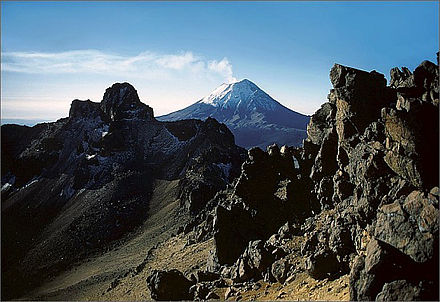
- Popocatepetl. Popocatepetl often has a volcanic plume above its crater which is high. The name means "smoking mountain" in the native Nahuatl language.
- Pico de Orizaba, 19.031581778575696°, -97.26997570258057°. This is the highest volcano in North America at . It last erupted in 1846.
- La Malinche, 19.230607370194996°, -98.03188657721°. Considered an active stratovolcano, though it last erupted in 1170 BC. Located in the Mexican state of Puebla. Elevation .
- Mount Pelée, 14.7417°, -61.1758°. An eruption here in 1902 wiped out the town of Saint-Pierre (Martinique). Attractions of the rebuilt town today include a volcano museum and wreck diving around the many ships sunk by that eruption.
- Soufrière Hills. Soufriere Hills on Montserrat, previously considered dormant, began erupting again in 1995, forcing the closure of the southern half of the island (including its capital and airport in 1997). It is still active, though mostly a nuisance seeping lava and spewing ash into the air.
Canada has no active volcanoes and is thought to have had only about 50 eruptions in the past 10,000 years. However, the Canadian Rockies include many dormant volcanoes; geologically they are part of the same system that produces active volcanoes in Washington, Oregon and Alaska.
South and Central America
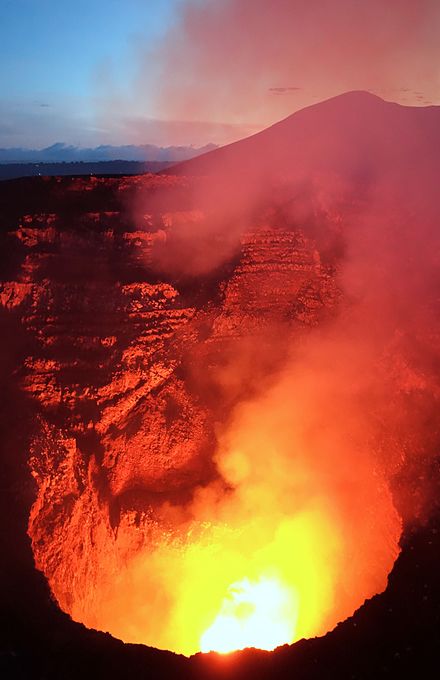
-
Cotopaxi, -0.68°, -78.438°. One of South America's most spectacular volcanoes.
-
Arenal. This is the youngest volcano in Costa Rica. Its eruptions were frequent until 2010, but now it is calm. Several companies in nearby towns offer tours.
-
Galeras. A Decade Volcano.
-
Volcan Santa Maria and Volcan Santiaguito in Guatemala, near Quetzaltenango.
-
Volcan de Fuego, Acatenango and Volcan Pacaya in Guatemala, near Antigua Guatemala. Guided hikes are available from the town.
-
Volcan Atitlan, Volcan San Pedro and Volcan Toliman in Guatemala, on the southern shores of Lake Atitlán.
-
Volcan Láscar in the Atacama Region of Northern Chile.
-
The Volcanoes of Concepción (active) and Maderas (dormant) that form the island of Ometepe , Nicaragua
Oceania
Hawaii
The entire Hawaiian island chain is volcanic in origin. Most of the volcanoes are of the shield volcano type, spread out rather than sharply conical
-
Kilauea, 19.397°, -155.29°. This volcano has been erupting continuously out of its flank vent, known as Pu'u O'o ("Hill of the O'o bird" in the native Hawai'ian language) since 1983. You can normally peer safely into its magma chamber from an observation point a couple of miles away in Hawaii Volcanoes National Park after nightfall.
-
Mauna Loa, 19.479444°, -155.602778°. Hawaii's highest historically active volcano, topped by the Moku'aweoeo Caldera. It is also the largest volcano by volume in the world. Don't be fooled by its gentle slopes – with its highest point at 4170m/13,683 ft) and the summit often covered in snow during the winter, the climb can be both difficult and dangerous for inexperienced hikers, and altitude sickness is a hazard for almost anyone. It is Hawaii's only Decade Volcano.
Its most recent eruption was in November and December 2022. -
Mauna Kea. This is the highest volcano in Hawaii at 4205 m (13,796 ft), and is pockmarked with cinder cones. Its high elevation is a magnet for astronomers with their giant telescope facilities, and even skiers. It is a dormant volcano; its last eruption was about 2460 BCE.
-
Haleakala (East Maui volcano). This is the tallest volcano on the island of Maui and makes up most of the island. It is renowned for its erosional crater and the cinder cones nestled inside. The name means "House of the sun" in Hawai'ian. There is a Haleakalā National Park around it.
New Zealand
- Tongariro National Park, -39.2°, 175.5833°. This park has three active volcanoes, Mount Ruapehu, Mount Tongariro and Mount Ngauruhoe. Ruapehu, New Zealand's highest volcano, has a crater lake that forms and fills when the volcano is not erupting. It's also a .
- White Island. is a volcanic island in the Bay of Plenty, southeast of Auckland, and the most active volcano in New Zealand. Tours used to go to the island, until an eruption in 2019 killed a large number of visitors. 2020-05-05
- Taupo, -38.6875°, 176.0694°. This town is located next to New Zealand's largest lake, which is the caldera of a supervolcano. It had a VEI-7 eruption in 180 CE that produced red skies as far away as Rome and China. Around 25,000 BCE it had a VEI-8 blast.
Papua New Guinea
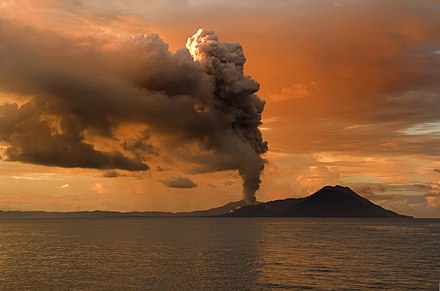
- Mount Tavurvur, -4.237235°, 152.208841°. This is a very active stratovolcano right next to the city of Rabaul on the island of New Britain. Much of the town was destroyed in a 1994 eruption. It last erupted in 2006, shattering windows up to 12 km away and sending an ash plume into the stratosphere.
- Mount Ulawun. This is another active stratovolcano on New Britain. It is New Guinea's only Decade Volcano.
Tonga
- Hunga Tonga, -20.536°, -175.382°. This undersea volcano had a series of eruptions starting in December 2021. On January 15 2022 it had largest eruption anywhere since Mount Pinatubo in 1991; this was a VEI-5 or 6 event and caused heavy damage in much of Tonga. An undersea cable was cut knocking out much of Tonga's communications and there was enough dust to close airports and make reconnaissance flights (which both Australia and NZ sent) difficult.
The eruption included an explosion loud enough to be heard as far away as Alaska and Australia, the largest volcanic explosion since Krakatoa in 1883. Tsunami warnings were issued in most Pacific nations, there was damage in areas as far apart as the US west coast and the Russian far east, and two people were killed by the waves in Chile.
Antarctica
Over 130 volcanoes have been discovered in the frozen wastelands of Antarctica, and with many erupting underneath the dense ice sheets they are not particularly practical to visit.
- Mount Erebus. At 3,794 metres (12,448 ft) Mount Erebus is the highest and most active volcano on the continent. There used to be aerial tours over the volcano from New Zealand until a fateful crash in 1979. Both the Scott and the Shackelton expeditions toward the South Pole passed near this volcano. 2020-05-05
Australia
- [ Heard Island and McDonald Islands](http://www.heardisland.aq), -53.09354°, 73.516992°. Almost 4000 kilometres from the Australian mainland, these two volcanoes are the only sort of active volcano anywhere in Australia. They are a UNESCO World Heritage Site because it's one of the only places with zilch introduced species and few human impacts. Access to the islands is not allowed, unless via permit. 2022-01-23
Travel agencies
In many areas — at least the Philippines, Italy and Costa Rica — many local travel agencies offer guided tours to their region's volcanoes. There are also agencies that specialize in volcano tourism.
-
Volcano Adventure Indonesia, Sukapura, Indonesia, tel. +62-335-581439, +62-81319090225. Tours to Mount Bromo and elsewhere in Indonesia.
-
VolcanoDiscovery, Germany, tel. +49 2241-2080175 , +30 2107522310 . This tour operator specializes in international volcanoes and one of its most important programs is for Indonesian volcanoes. The tours are trekking & photography tours with small groups and an intensive personal service. The tours are usually about 7–14 days.